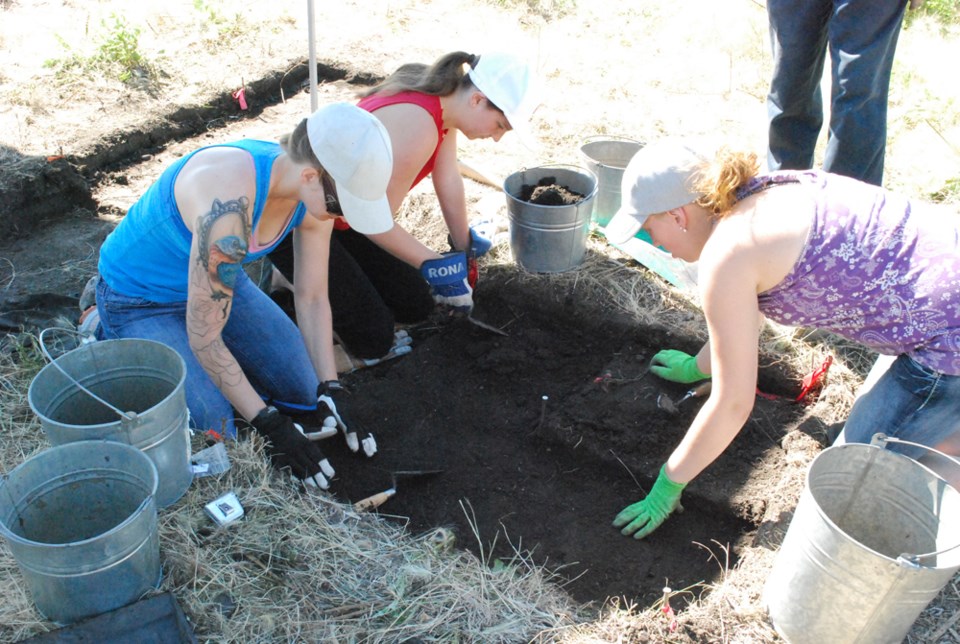It was a well documented site and volunteers spent Jul. 18-22 digging it up.
Located 8 kilometres out of town, Original Humboldt is rich with Saskatchewan’s communication, cultural, aboriginal, and military history.
Jim Finnigan with Western Heritage lead the team of archeologists and volunteers as the excavated the Telegraph Station located on the eastern side of the site.
Finnigan says they did an east to west trench in 2009 when they first excavated the Telegraph Station but now are digging a north to south trench to feel out how big the station was.
“We’re seeing the original floor of the Telegraph Station. So far...we’ve found a patent medicine bottle, some cloth, lots and lots of buttons, household items that you’d expect to find in a place people lived in and worked in.”
The Telegraph Station was part of the Dominion telegraph line that ran from Winnipeg to Edmonton, completed in 1876.
The Weldons’ were the first residents of Original Humboldt; Catherine, the first female telegraph operator in the west and her husband, George, a lineman who inspected the lines, along with their daughter, Birdie.
The site has had a complete history, says Finnigan, both being part of the telegraph line and being located on the Carlton Trail.
Many travellers mentioned the Weldon’s hospitality in the short time they were there.
Finnigan says that they are finding items where they were dropped and lost in the floor.
If they did not know about the Telegraph Station, Finnigan says they found enough telegraph wire and insulator glass to know that was the intent of the building.
After the Weldon’s moved to Grenfell after the death of Birdie, the post was used as a mail station before it became Fort Denison during the North West Resistance.
The fort was located on the north western portion of Original Humboldt and has been excavated on previous occasions and has many differences compared to the Telegraph Station.
When excavating the site, they dug up trash pits where all the waste was thrown, from different sized food tins to discarded military material.
In Original Humboldt’s short history, the site was used quite frequently so the variety of things found is quite extensive and unique to the time frame.
“We’re not finding 1910 homestead materials... same at the other site. We didn’t find much contemporary material which is not surprising,” says Finnigan.
Even without the artifact, a lot is known about the site. They know what the site looked like through George Weldon’s diary that was reprinted in the Regina Leader Post in 1931, sketches done by artist, Sydney Prior Hall, and photos done by the military. But where the artifacts are found is a significant insight into the site as well, says Finnigan, since distribution of the artifacts tells what parts of the building was used for.
Along with digging for artifacts, radar equipment is also used on the site to look for anomalies in areas not yet excavated.
With two different types of radar, Finnigan says one can find tiny objects but can only scan down 8-10 inches while another scan can go down further.
Finnigan was hoping to find the Telegraph Station floor with the scanner but either way it is an experiment, he says.
“We’ve always tried to bring the latest technology out here and try different things.”
Humboldt and District Museum and Gallery Director, Jennifer Fitzpatrick, has been very appreciative of Western Heritage, who was a part of founding the site in 1995 and has come out for every archeological dig since 2009.
This years archeological project and the return to the Telegraph Station is in correlation to Canada’s 150th anniversary, says Fitzpatrick.
The Telegraph Station is a big part of Saskatchewan, and even Canada’s, communication history and is the only marked station in Canada.
The Dominion Telegraph Line was the first communication connection through the west and especially on the eve of Canada’s 150 anniversary, is a major piece of Canadian development, says Fitzpatrick.
“The building of the Dominion Telegraph Line is national...the Telegraph Station is a critic aspect of that communication across the country.”
Fitzpatrick says they are hoping to expand their public archeology next year with a bigger field school at the site, including one that is specifically for students.
“It’s very rare to do an archeological dig right in your backyard,” says Fitzpatrick, so they are hoping people who want to be a part of it will come out.
There is always something new to find both at the Telegraph Station and Fort Denison, says Finnigan, so he is happy to come back next year with solutions to problems they have had in years previous.
One thing they have not found yet is the latrine which would be an amazing find, he says.
The archeological digs are sponsored by the Saskatchewan Heritage Foundation.
“There’s not a lot of locations for research funding in Saskatchewan and so they’re a really big partner with us to do this original research with professional archeologists and really understand the extent of this 80 acres of land that we are stewards of.”
Those who are interested in joining an archeological dig at Original Humboldt can contact the Museum at anytime, says Fitzpatrick.




